Chapter 10 India – Soils Of India Introduction :
Soil:
Soil is an important natural resource. Mankind has lived and continues to live on the soil. Many human and economic activities depend upon soils. All our food comes directly or indirectly from the soil.
Livestock farming depends upon the raising of grass on different soils. Soils form an important element for all living things. Soils have affected the march of civilizations.
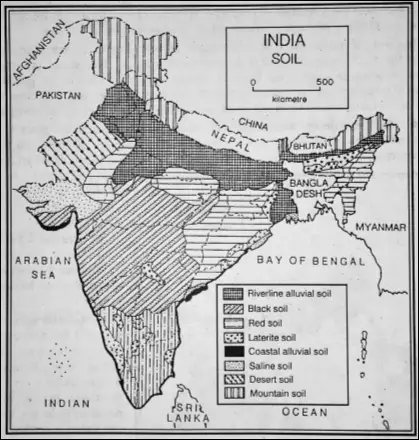
Soil :
Soil is the topmost layer on the surface of the Earth. The loose inorganic and organic unconsolidated material which forms the uppermost layer of the Earth’s crust and promotes the growth of vegetation cover is called ‘soil’. The soil is consisting of
- Inorganic material derived from rocks;
- Organic matter derived mainly from plant residues;
- Water and air within pores; and
- Millions of small living organisms.
Read and Learn More WBBSE Notes For Class 6 Junior School Geography
The Formation of Soil :
The change from hard and rugged rocks to soft, fine-grained soil takes a long time. The first step in this direction is the disintegration or weathering of rocks. The disintegration of rock by weathering often produces a layer of loose rock materials.
This covering of loose materials over the primary rock bed is known as ‘regolith’. Soil is derived from regolith in different natural processes.
The main factors in the formation of soils are-
- Parent rock materials,
- Topography or relief,
- Climate,
- Organic matter (plants and animals) and
- Time.
The texture and structure of soils depend on parent rocks. The climate is considered to be the most important factor in the development of soil. Steep slopes have thin soil layers, whereas the valleys and lowlands possess thick fertile soil.
The soil gets humus from plants. Earthworms and other animals like dogs, squirrels etc. also upturns the soil of the lower layer soils in wet areas require less time to develop than in dry areas.
Soils in different parts of India :
In India, there are different types of soils. The Indian Council of Agricultural Research (ICAR) set up on ‘All India Soil Survey Committee in 1953 which divided Indian soils into 27 types of soils in which 8 types are important. As per the syllabus six of the eight major soil types are discussed below :
Alluvial soil :
Alluvial soil is the principal soil of India. It covers about 46% of the total land of our country.
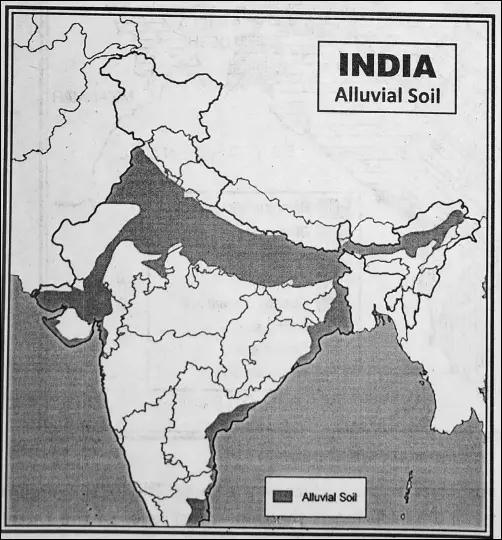
Location Of Alluvial soil :
The alluvial soils are found in the Vast riverine tract of the Indus, Sutlej, Ganga and Brahmaputra in the Northern Plains, in the deltas of Godavari, Krishna and Kaveri rivers. The states of Punjab, Haryana, Uttar Pradesh, Bihar, West Bengal, Assam, Odisha and other coastal (eastern) states have alluvial soil.
Characteristics Of Alluvial soil :
- Alluvial soils are deposited by rivers.
- These soils are limited to river basins and plains.
- These are very fertile soils.
- These consist of fine-grained clay and sand.
- These soils are rich in potash, but poor in phosphorus.
- These are generally deep soils.
Influence on Agriculture :
Riverine alluvium is very fertile. These soils favour the cultivation of rice, wheat, jute, cotton, oilseeds, sugarcane, millets, pulses, tobacco and vegetable. Coastal alluvial soil is developed in paddy, coconut, and green chilly cultivation. So, the alluvial soil is regarded as the best soil of India for its high agricultural value.
Black soil :
This is the second most important soil of India. It is popularly known as ‘Regur’ and ‘black cotton soil’ also. It covers about 17% of the total land area of India.
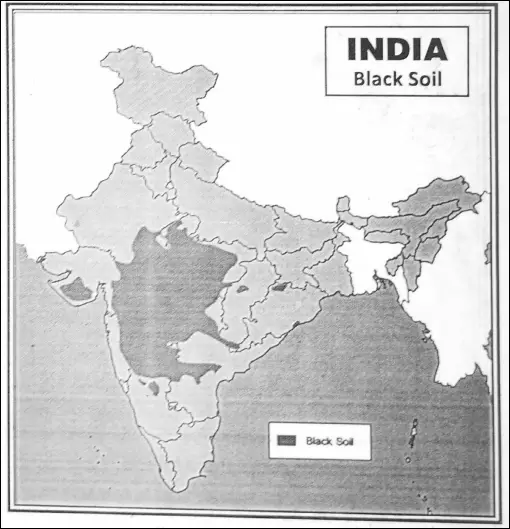
Location Of Black Soil :
Black soil is found in the ‘Deccan Trap’, especially in Maharashtra, the southern part of Gujarat, Madhya Pradesh, the Northern part of Karnataka, Telangana and Northern part of Tamil Nadu.
Characteristics Of Black soil :
- This soil is produced from lava rock ‘basalt’. The colour of basalt is black. Hence, colour of this rock is black.
- It contains calcium, magnesium, carbonates, iron-oxides and humous
- Nitrogenous materials are totally absent in this soil.
- It has high water retentive capacity.
- It is sticky in nature.
- It is fine-grained and clay soil. As cotton thrives well in this soil, it is popularly known as ‘Black Cotton Soil’.
Influence on Agriculture :
Regur or Black soils are fertile and are suitable for cotton, wheat, sugarcane and groundnut production.
Red soil:
This soil is formed by the breaking down of metamorphic rocks over the year. It is red in colour of the high of iron that it contains.

Location Of Red Soil :
This soil is found in peninsular India, particularly in the states of Odisha, Jharkhand, Chhattisgarh, Telangana, Andhra Pradesh, Tamil Nadu, Kerala, Manipur, Mizoram, Nagaland, Arunachal Pradesh and the Western part of West Bengal.
Characteristics Of Red Soil :
- This soil is a mixture of sand and clay.
- It is red in colour as it contains a great proportion of iron oxides.
- It is deficient in nitrogen, phosphoric acid and humus, but it is rich in potash and lime.
Influence on Agriculture :
This soil is relatively less fertile, but cultivation is possible with the help of irrigation and fertilizers. Ragi, rice, wheat, millets, nuts, pulses, sugarcane, oilseeds, cotton and chick peas are cultivated on these soils.
Laterite soil :
It takes place under typical monsoonal conditions. The alteration of wet and dry seasons leads to the leaching away of the siliceous matter of the rocks and the formation of laterite soils takes place.
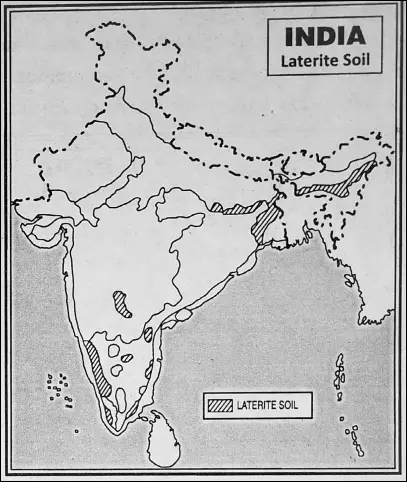
Location Of Laterite Soil :
They are commonly found in Karnataka, Kerala, Tamil Nadu, Maharashtra, Madhya Pradesh, Chhattisgarh, Odisha, Chhotonagpur plateau, mountains in Western Ghats and Eastern Ghats, and in large areas of plateaus in Meghalaya.
Characteristics Of Laterite Soil :
- The laterite soils are hard as a brick (‘later’ means brick). So, it is named by laterite.
- Laterite soil is formed in areas of high temperature and heavy rainfall where dry and wet seasons follow each other.
- It is red in colour because of the high amount of iron oxide that contains.
- These are shallow, acidic and less fertile.
- These are less fertile due to the leaching of soil.
- These are poor in nitrogen, and potash, but rich in iron.
Influence on Agriculture :
Though this soil is infertile, it is unsuitable for agriculture. Hardy crops like jowar, bajra, ragi, groundnuts etc. are cultivated on this soil.
Desert soil or soil of desert region :
This soil is formed in areas of little rainfall and excessive temperature.
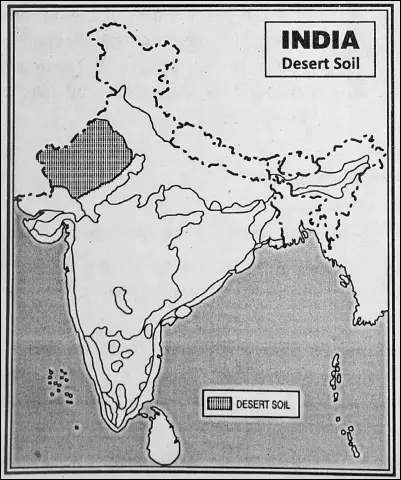
Location Of Desert Soil :
These soils are found in Rajasthan deserts, the southern part of Punjab and the Rann of Kachchh.
Characteristics Of Desert Soil :
- These soils contain coarse brown sands.
- They are granular and very porous.
- It has the little water-retaining capacity and is infertile.
- The amount of salt In this soil is high because of excessive evaporation.
Influence on Agriculture :
These soils are not suitable for agriculture. Millet like ragi, bajra and wheat, groundnut can be grown on these soils.
Mountain soil or soil of mountainous region :
This soil is formed in a humid temperate climates.
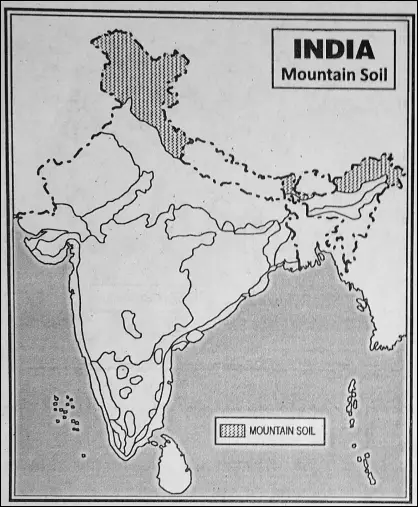
Location Of Mountain Soil :
It is found particularly in those areas which have mountains or hill ranges, these soils are found in the states of Jammu and Kashmir, Himachal Pradesh, Arunachal Pradesh and Uttarakhand. These are also found in Nilgiri hills and hills in Western Ghats
Characteristics Of Mountain Soil :
- These soils are made of rock, boulders and clay.
- It contains a large amount of organic matter.
- These are generally light black in colour with a large number of rock particles.
Influence on Agriculture :
These soils cannot be termed good from the point of view of agriculture. However, these soils are suitable for cultivating tea, coffee, rice, fruits and different spices.
The Uses of Soils :
Soil is a fundamental natural resource. There are various uses of soils. The important uses of soils are as follows :
- Agriculture is not possible without soil as it is the storehouse of plant nutrients.
- Soil is a natural habitat for various insects, earthworms and microscopic creatures.
- Livestock farming depends upon the raising of grass on different soils.
- Soils help to maintain humidity in the environment.
- The soil is used as materials for the construction of buildings etc.
- The soil is used for clay modelling.
- Soils are the origins of plants and forests.
- Soils help to establish cottage industries.
Soil Erosion :
Soil erosion may be defined as the detachment and transportation of soil by agents of denudation such as weathering; running water and wind etc. It is the destruction and removal of topsoil.
Soil erosion has become a serious problem in many areas of India as well as the world. Soil erosion results from the following causes :
Causes of Soil Erosion :
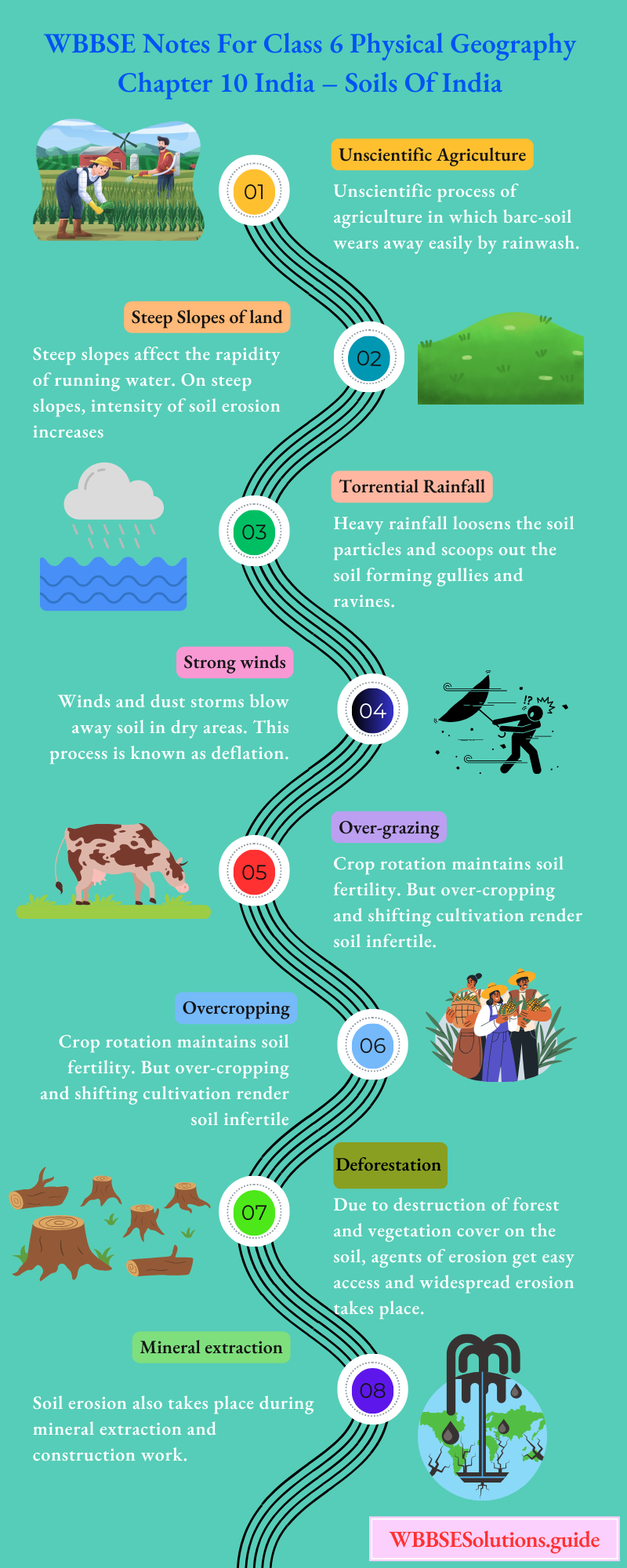
Soil Conservation :
The process of preventing soil erosion and degradation by natural as well as artificial methods is known as ‘soil conservation’. The different methods of soil conservation are as follows :
(1) Afforestation :
The primary way to control soil erosion is to plant many trees and grasses, which give cover to the exposed dry land.
(2) Controlled Grazing :
The number of cattle to be grazed on slopes should be according to the carrying capacity of the pastures.
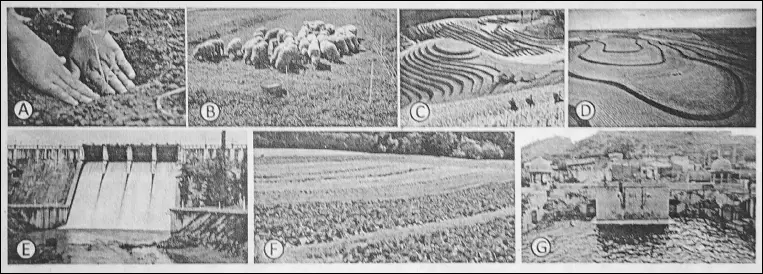
(3) Terraced agriculture :
Slopes must be cut into a series of terraces for cultivation so as to slow down the flow of rainwater.
(4) Contour ploughing :
Contour ploughing, terracing and building is done to check soil wash on slopes. Ploughing is done at right angles to the hill slopes.
(5) Construction of river dams :
River dams are built in the upper course of rivers to control floods and check soil erosion.
(6) Crop rotation :
A crop rotation system be applied and the land should be allowed fallow for some time. Soil fertility can be maintained in this way.
(7) Other methods :
In areas of heavy rain, basin type of cultivation be adopted. Tall trees should be grown as windbreaks and shelter belts in areas of strong winds. Roads, buildings and houses should not be constructed along the slopes.
WBBSE Notes for Class 6 Junior School Geography
- Chapter 1 The Universe and Solar System
- Chapter 2 Shape of The Earth: Is The Earth Around?
- Chapter 3 Location of a Place on The Earth’ Surface: Where You Are
- Chapter 4 The Earth’s Motion: The Earth Rotation
- Chapter 5 Water – Land – Air
- Chapter 6 The Ice Capped Continent: Antartica
- Chapter 7 Weather And Climate
- Chapter 8 Air Pollution
- Chapter 9 Noise Pollution
- Chapter 10 India
